International Trade, Finance and Investment
VerifiedAdded on 2023/01/19
|19
|4724
|31
AI Summary
This report discusses the concepts of international trade, finance, and investment. It covers the background of financial markets, capital allocation to domestic and international markets, and the evaluation of emerging economies. It also explores the challenges faced by countries due to industrialization and trade policies. The report highlights the role of the London Stock Exchange and international capital markets in promoting economic growth.
Contribute Materials
Your contribution can guide someone’s learning journey. Share your
documents today.
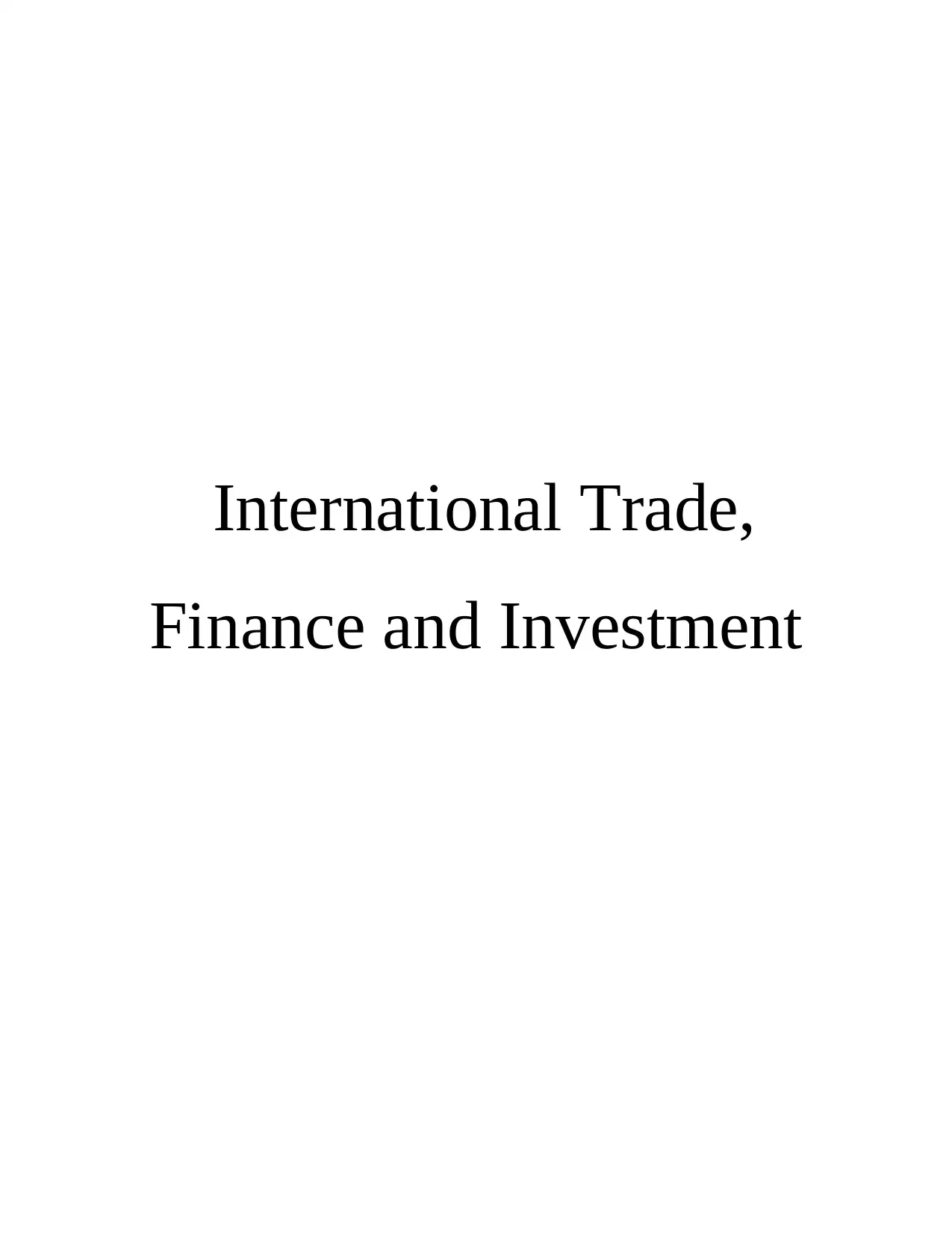
International Trade,
Finance and Investment
Finance and Investment
Secure Best Marks with AI Grader
Need help grading? Try our AI Grader for instant feedback on your assignments.
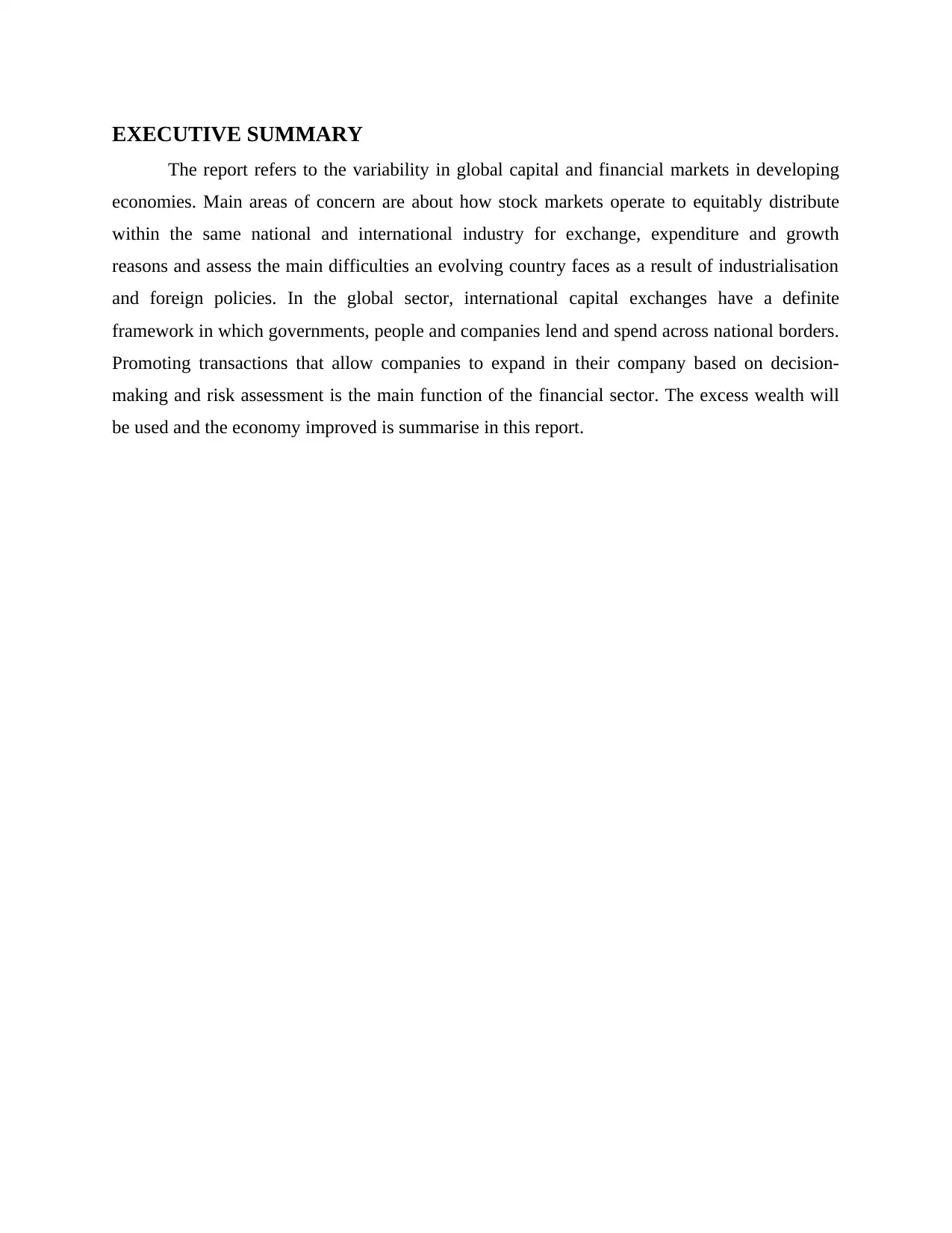
EXECUTIVE SUMMARY
The report refers to the variability in global capital and financial markets in developing
economies. Main areas of concern are about how stock markets operate to equitably distribute
within the same national and international industry for exchange, expenditure and growth
reasons and assess the main difficulties an evolving country faces as a result of industrialisation
and foreign policies. In the global sector, international capital exchanges have a definite
framework in which governments, people and companies lend and spend across national borders.
Promoting transactions that allow companies to expand in their company based on decision-
making and risk assessment is the main function of the financial sector. The excess wealth will
be used and the economy improved is summarise in this report.
The report refers to the variability in global capital and financial markets in developing
economies. Main areas of concern are about how stock markets operate to equitably distribute
within the same national and international industry for exchange, expenditure and growth
reasons and assess the main difficulties an evolving country faces as a result of industrialisation
and foreign policies. In the global sector, international capital exchanges have a definite
framework in which governments, people and companies lend and spend across national borders.
Promoting transactions that allow companies to expand in their company based on decision-
making and risk assessment is the main function of the financial sector. The excess wealth will
be used and the economy improved is summarise in this report.

Table of Contents
EXECUTIVE SUMMARY ............................................................................................................2
INTRODUCTION...........................................................................................................................1
QUESTION 1...................................................................................................................................1
Background of financial market...................................................................................................1
Domestic economy and capital allocation...................................................................................2
International economy and capital allocation..............................................................................6
Theory of trade, financial and investment...................................................................................9
Contributions in international trade.............................................................................................9
QUESTION 2...................................................................................................................................9
Evaluation of emerging economy................................................................................................9
Critical evaluation of challenges................................................................................................11
CONCLUSION..............................................................................................................................13
REFERENCERS ...........................................................................................................................14
EXECUTIVE SUMMARY ............................................................................................................2
INTRODUCTION...........................................................................................................................1
QUESTION 1...................................................................................................................................1
Background of financial market...................................................................................................1
Domestic economy and capital allocation...................................................................................2
International economy and capital allocation..............................................................................6
Theory of trade, financial and investment...................................................................................9
Contributions in international trade.............................................................................................9
QUESTION 2...................................................................................................................................9
Evaluation of emerging economy................................................................................................9
Critical evaluation of challenges................................................................................................11
CONCLUSION..............................................................................................................................13
REFERENCERS ...........................................................................................................................14

Secure Best Marks with AI Grader
Need help grading? Try our AI Grader for instant feedback on your assignments.
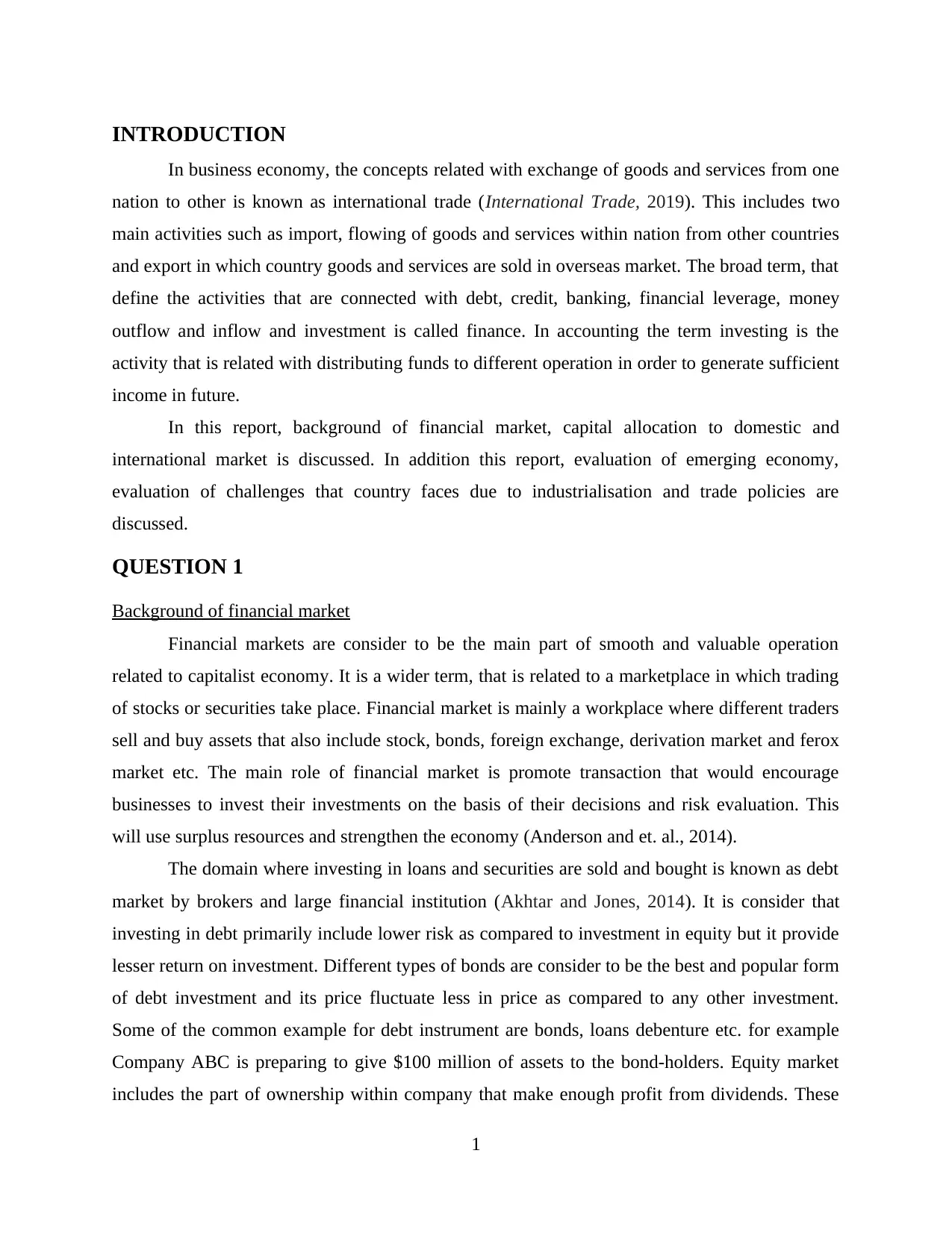
INTRODUCTION
In business economy, the concepts related with exchange of goods and services from one
nation to other is known as international trade (International Trade, 2019). This includes two
main activities such as import, flowing of goods and services within nation from other countries
and export in which country goods and services are sold in overseas market. The broad term, that
define the activities that are connected with debt, credit, banking, financial leverage, money
outflow and inflow and investment is called finance. In accounting the term investing is the
activity that is related with distributing funds to different operation in order to generate sufficient
income in future.
In this report, background of financial market, capital allocation to domestic and
international market is discussed. In addition this report, evaluation of emerging economy,
evaluation of challenges that country faces due to industrialisation and trade policies are
discussed.
QUESTION 1
Background of financial market
Financial markets are consider to be the main part of smooth and valuable operation
related to capitalist economy. It is a wider term, that is related to a marketplace in which trading
of stocks or securities take place. Financial market is mainly a workplace where different traders
sell and buy assets that also include stock, bonds, foreign exchange, derivation market and ferox
market etc. The main role of financial market is promote transaction that would encourage
businesses to invest their investments on the basis of their decisions and risk evaluation. This
will use surplus resources and strengthen the economy (Anderson and et. al., 2014).
The domain where investing in loans and securities are sold and bought is known as debt
market by brokers and large financial institution (Akhtar and Jones, 2014). It is consider that
investing in debt primarily include lower risk as compared to investment in equity but it provide
lesser return on investment. Different types of bonds are consider to be the best and popular form
of debt investment and its price fluctuate less in price as compared to any other investment.
Some of the common example for debt instrument are bonds, loans debenture etc. for example
Company ABC is preparing to give $100 million of assets to the bond-holders. Equity market
includes the part of ownership within company that make enough profit from dividends. These
1
In business economy, the concepts related with exchange of goods and services from one
nation to other is known as international trade (International Trade, 2019). This includes two
main activities such as import, flowing of goods and services within nation from other countries
and export in which country goods and services are sold in overseas market. The broad term, that
define the activities that are connected with debt, credit, banking, financial leverage, money
outflow and inflow and investment is called finance. In accounting the term investing is the
activity that is related with distributing funds to different operation in order to generate sufficient
income in future.
In this report, background of financial market, capital allocation to domestic and
international market is discussed. In addition this report, evaluation of emerging economy,
evaluation of challenges that country faces due to industrialisation and trade policies are
discussed.
QUESTION 1
Background of financial market
Financial markets are consider to be the main part of smooth and valuable operation
related to capitalist economy. It is a wider term, that is related to a marketplace in which trading
of stocks or securities take place. Financial market is mainly a workplace where different traders
sell and buy assets that also include stock, bonds, foreign exchange, derivation market and ferox
market etc. The main role of financial market is promote transaction that would encourage
businesses to invest their investments on the basis of their decisions and risk evaluation. This
will use surplus resources and strengthen the economy (Anderson and et. al., 2014).
The domain where investing in loans and securities are sold and bought is known as debt
market by brokers and large financial institution (Akhtar and Jones, 2014). It is consider that
investing in debt primarily include lower risk as compared to investment in equity but it provide
lesser return on investment. Different types of bonds are consider to be the best and popular form
of debt investment and its price fluctuate less in price as compared to any other investment.
Some of the common example for debt instrument are bonds, loans debenture etc. for example
Company ABC is preparing to give $100 million of assets to the bond-holders. Equity market
includes the part of ownership within company that make enough profit from dividends. These
1
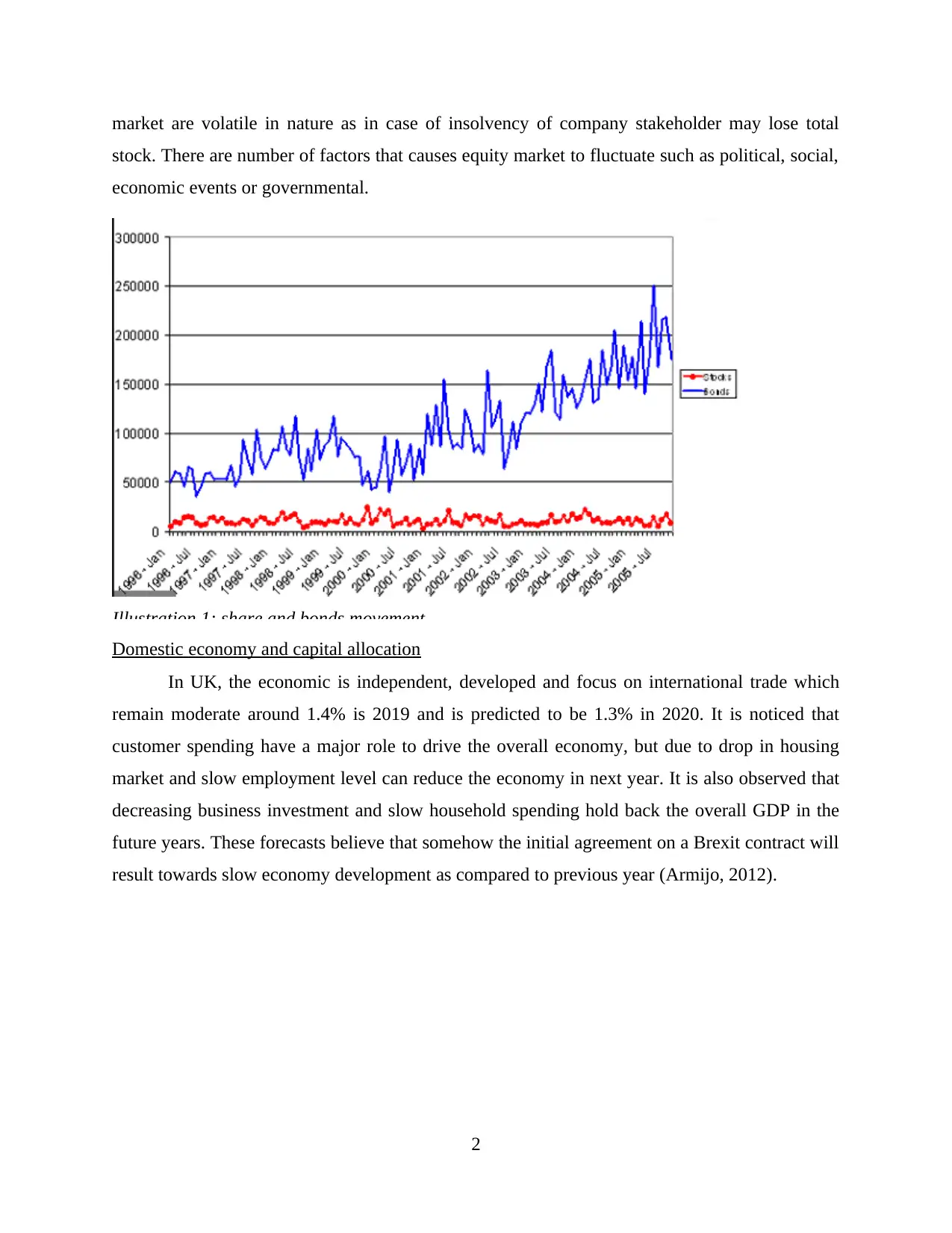
market are volatile in nature as in case of insolvency of company stakeholder may lose total
stock. There are number of factors that causes equity market to fluctuate such as political, social,
economic events or governmental.
Illustration 1: share and bonds movement
Domestic economy and capital allocation
In UK, the economic is independent, developed and focus on international trade which
remain moderate around 1.4% is 2019 and is predicted to be 1.3% in 2020. It is noticed that
customer spending have a major role to drive the overall economy, but due to drop in housing
market and slow employment level can reduce the economy in next year. It is also observed that
decreasing business investment and slow household spending hold back the overall GDP in the
future years. These forecasts believe that somehow the initial agreement on a Brexit contract will
result towards slow economy development as compared to previous year (Armijo, 2012).
2
stock. There are number of factors that causes equity market to fluctuate such as political, social,
economic events or governmental.
Illustration 1: share and bonds movement
Domestic economy and capital allocation
In UK, the economic is independent, developed and focus on international trade which
remain moderate around 1.4% is 2019 and is predicted to be 1.3% in 2020. It is noticed that
customer spending have a major role to drive the overall economy, but due to drop in housing
market and slow employment level can reduce the economy in next year. It is also observed that
decreasing business investment and slow household spending hold back the overall GDP in the
future years. These forecasts believe that somehow the initial agreement on a Brexit contract will
result towards slow economy development as compared to previous year (Armijo, 2012).
2
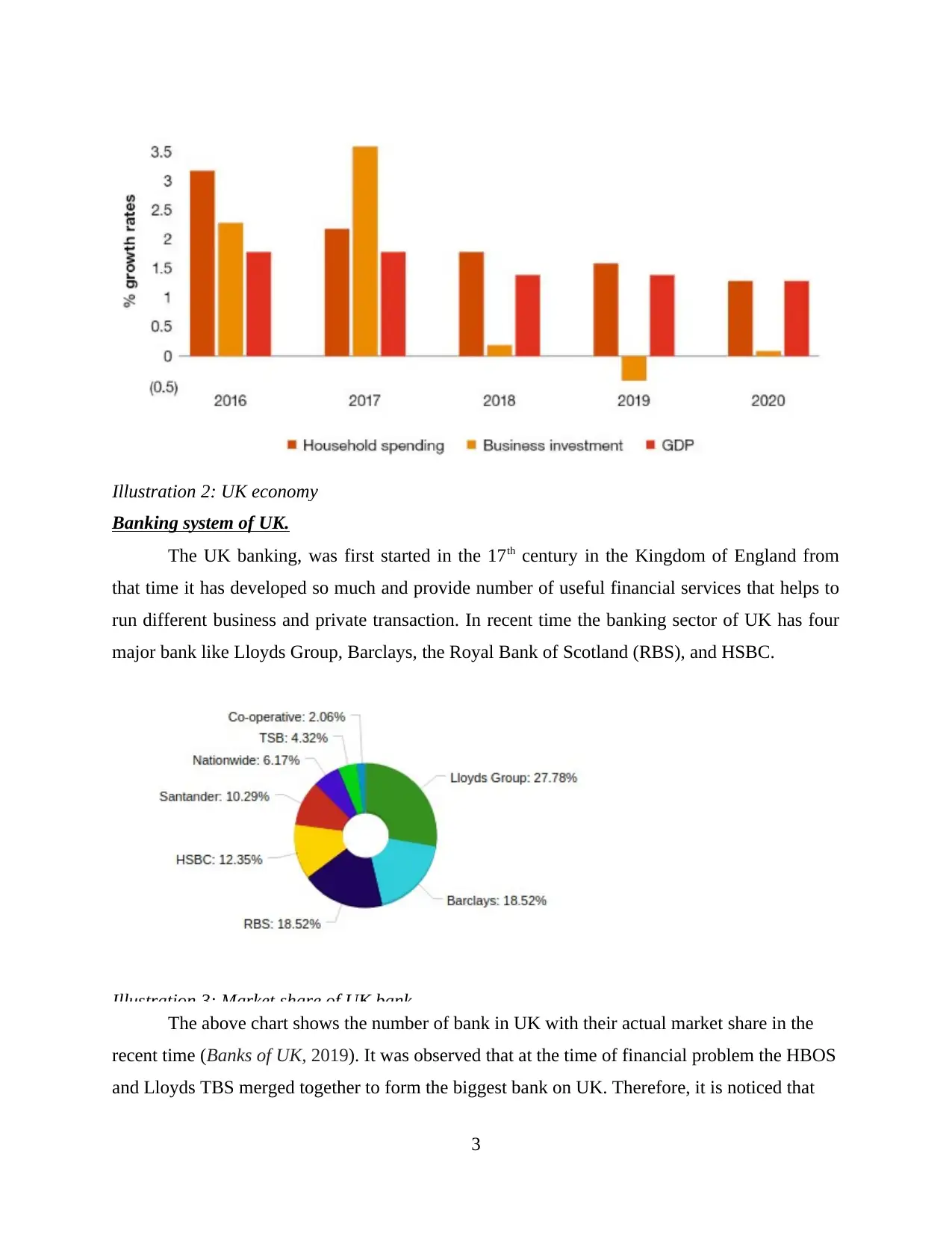
Illustration 2: UK economy
Banking system of UK.
The UK banking, was first started in the 17th century in the Kingdom of England from
that time it has developed so much and provide number of useful financial services that helps to
run different business and private transaction. In recent time the banking sector of UK has four
major bank like Lloyds Group, Barclays, the Royal Bank of Scotland (RBS), and HSBC.
Illustration 3: Market share of UK bank.
The above chart shows the number of bank in UK with their actual market share in the
recent time (Banks of UK, 2019). It was observed that at the time of financial problem the HBOS
and Lloyds TBS merged together to form the biggest bank on UK. Therefore, it is noticed that
3
Banking system of UK.
The UK banking, was first started in the 17th century in the Kingdom of England from
that time it has developed so much and provide number of useful financial services that helps to
run different business and private transaction. In recent time the banking sector of UK has four
major bank like Lloyds Group, Barclays, the Royal Bank of Scotland (RBS), and HSBC.
Illustration 3: Market share of UK bank.
The above chart shows the number of bank in UK with their actual market share in the
recent time (Banks of UK, 2019). It was observed that at the time of financial problem the HBOS
and Lloyds TBS merged together to form the biggest bank on UK. Therefore, it is noticed that
3
Paraphrase This Document
Need a fresh take? Get an instant paraphrase of this document with our AI Paraphraser
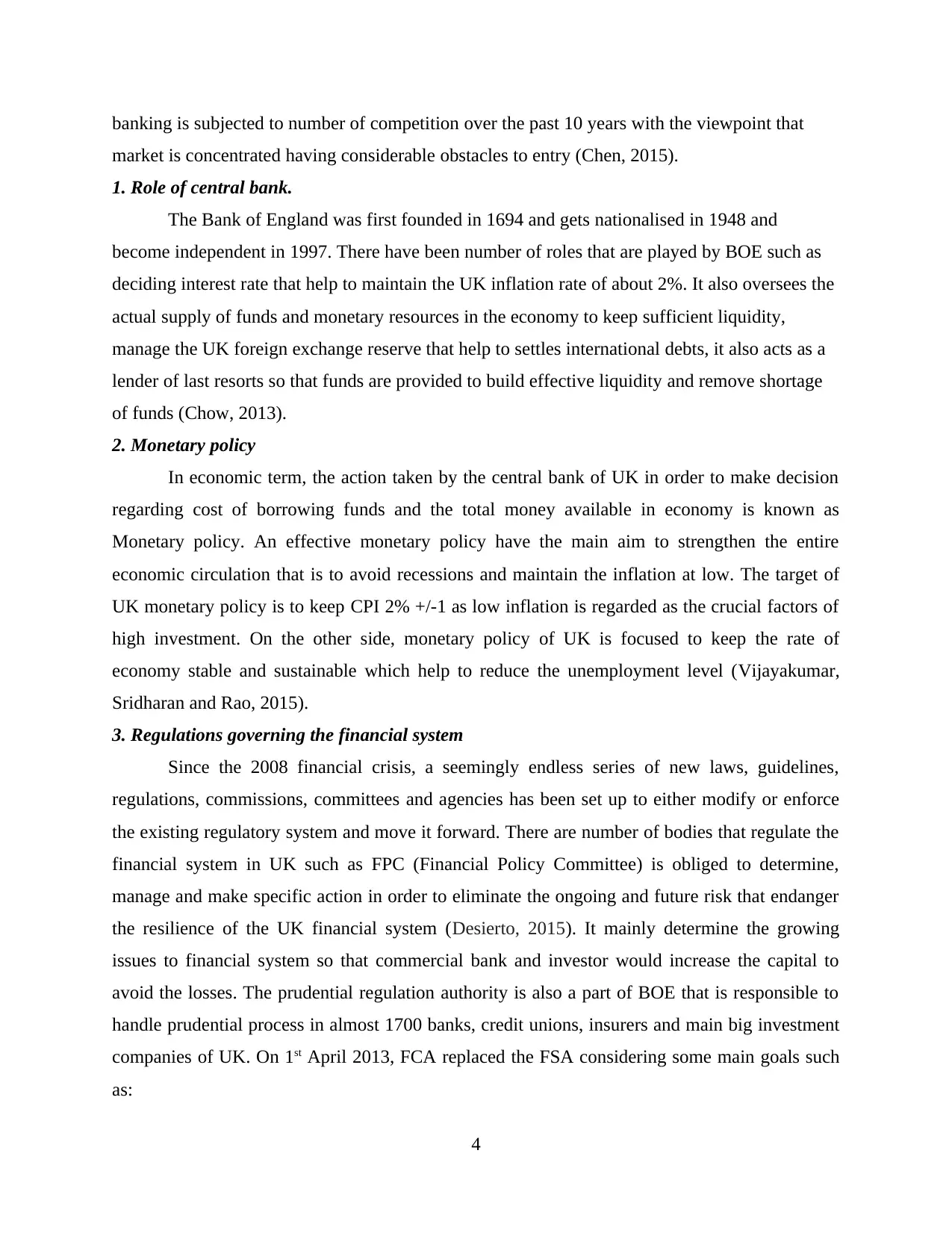
banking is subjected to number of competition over the past 10 years with the viewpoint that
market is concentrated having considerable obstacles to entry (Chen, 2015).
1. Role of central bank.
The Bank of England was first founded in 1694 and gets nationalised in 1948 and
become independent in 1997. There have been number of roles that are played by BOE such as
deciding interest rate that help to maintain the UK inflation rate of about 2%. It also oversees the
actual supply of funds and monetary resources in the economy to keep sufficient liquidity,
manage the UK foreign exchange reserve that help to settles international debts, it also acts as a
lender of last resorts so that funds are provided to build effective liquidity and remove shortage
of funds (Chow, 2013).
2. Monetary policy
In economic term, the action taken by the central bank of UK in order to make decision
regarding cost of borrowing funds and the total money available in economy is known as
Monetary policy. An effective monetary policy have the main aim to strengthen the entire
economic circulation that is to avoid recessions and maintain the inflation at low. The target of
UK monetary policy is to keep CPI 2% +/-1 as low inflation is regarded as the crucial factors of
high investment. On the other side, monetary policy of UK is focused to keep the rate of
economy stable and sustainable which help to reduce the unemployment level (Vijayakumar,
Sridharan and Rao, 2015).
3. Regulations governing the financial system
Since the 2008 financial crisis, a seemingly endless series of new laws, guidelines,
regulations, commissions, committees and agencies has been set up to either modify or enforce
the existing regulatory system and move it forward. There are number of bodies that regulate the
financial system in UK such as FPC (Financial Policy Committee) is obliged to determine,
manage and make specific action in order to eliminate the ongoing and future risk that endanger
the resilience of the UK financial system (Desierto, 2015). It mainly determine the growing
issues to financial system so that commercial bank and investor would increase the capital to
avoid the losses. The prudential regulation authority is also a part of BOE that is responsible to
handle prudential process in almost 1700 banks, credit unions, insurers and main big investment
companies of UK. On 1st April 2013, FCA replaced the FSA considering some main goals such
as:
4
market is concentrated having considerable obstacles to entry (Chen, 2015).
1. Role of central bank.
The Bank of England was first founded in 1694 and gets nationalised in 1948 and
become independent in 1997. There have been number of roles that are played by BOE such as
deciding interest rate that help to maintain the UK inflation rate of about 2%. It also oversees the
actual supply of funds and monetary resources in the economy to keep sufficient liquidity,
manage the UK foreign exchange reserve that help to settles international debts, it also acts as a
lender of last resorts so that funds are provided to build effective liquidity and remove shortage
of funds (Chow, 2013).
2. Monetary policy
In economic term, the action taken by the central bank of UK in order to make decision
regarding cost of borrowing funds and the total money available in economy is known as
Monetary policy. An effective monetary policy have the main aim to strengthen the entire
economic circulation that is to avoid recessions and maintain the inflation at low. The target of
UK monetary policy is to keep CPI 2% +/-1 as low inflation is regarded as the crucial factors of
high investment. On the other side, monetary policy of UK is focused to keep the rate of
economy stable and sustainable which help to reduce the unemployment level (Vijayakumar,
Sridharan and Rao, 2015).
3. Regulations governing the financial system
Since the 2008 financial crisis, a seemingly endless series of new laws, guidelines,
regulations, commissions, committees and agencies has been set up to either modify or enforce
the existing regulatory system and move it forward. There are number of bodies that regulate the
financial system in UK such as FPC (Financial Policy Committee) is obliged to determine,
manage and make specific action in order to eliminate the ongoing and future risk that endanger
the resilience of the UK financial system (Desierto, 2015). It mainly determine the growing
issues to financial system so that commercial bank and investor would increase the capital to
avoid the losses. The prudential regulation authority is also a part of BOE that is responsible to
handle prudential process in almost 1700 banks, credit unions, insurers and main big investment
companies of UK. On 1st April 2013, FCA replaced the FSA considering some main goals such
as:
4
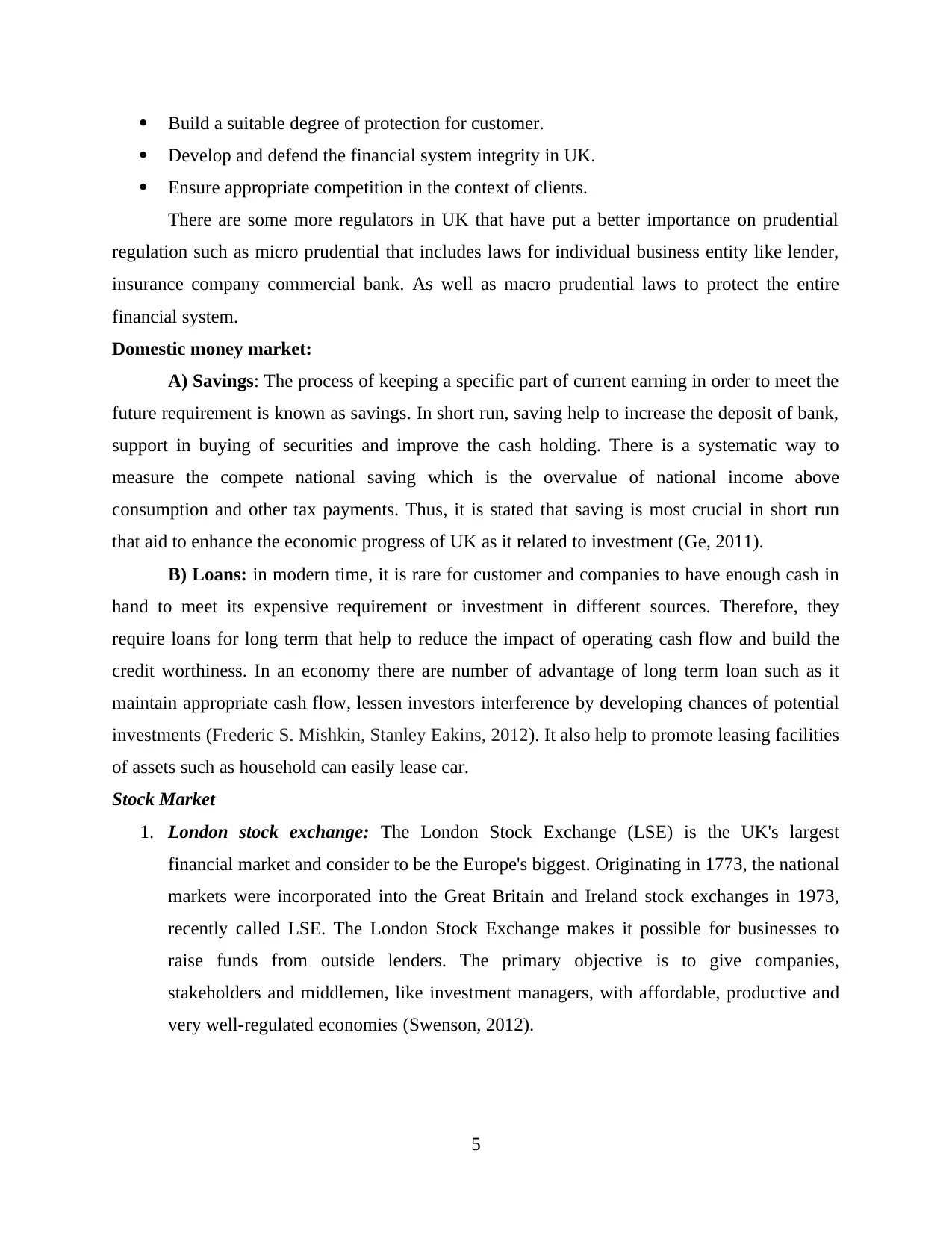
Build a suitable degree of protection for customer.
Develop and defend the financial system integrity in UK.
Ensure appropriate competition in the context of clients.
There are some more regulators in UK that have put a better importance on prudential
regulation such as micro prudential that includes laws for individual business entity like lender,
insurance company commercial bank. As well as macro prudential laws to protect the entire
financial system.
Domestic money market:
A) Savings: The process of keeping a specific part of current earning in order to meet the
future requirement is known as savings. In short run, saving help to increase the deposit of bank,
support in buying of securities and improve the cash holding. There is a systematic way to
measure the compete national saving which is the overvalue of national income above
consumption and other tax payments. Thus, it is stated that saving is most crucial in short run
that aid to enhance the economic progress of UK as it related to investment (Ge, 2011).
B) Loans: in modern time, it is rare for customer and companies to have enough cash in
hand to meet its expensive requirement or investment in different sources. Therefore, they
require loans for long term that help to reduce the impact of operating cash flow and build the
credit worthiness. In an economy there are number of advantage of long term loan such as it
maintain appropriate cash flow, lessen investors interference by developing chances of potential
investments (Frederic S. Mishkin, Stanley Eakins, 2012). It also help to promote leasing facilities
of assets such as household can easily lease car.
Stock Market
1. London stock exchange: The London Stock Exchange (LSE) is the UK's largest
financial market and consider to be the Europe's biggest. Originating in 1773, the national
markets were incorporated into the Great Britain and Ireland stock exchanges in 1973,
recently called LSE. The London Stock Exchange makes it possible for businesses to
raise funds from outside lenders. The primary objective is to give companies,
stakeholders and middlemen, like investment managers, with affordable, productive and
very well-regulated economies (Swenson, 2012).
5
Develop and defend the financial system integrity in UK.
Ensure appropriate competition in the context of clients.
There are some more regulators in UK that have put a better importance on prudential
regulation such as micro prudential that includes laws for individual business entity like lender,
insurance company commercial bank. As well as macro prudential laws to protect the entire
financial system.
Domestic money market:
A) Savings: The process of keeping a specific part of current earning in order to meet the
future requirement is known as savings. In short run, saving help to increase the deposit of bank,
support in buying of securities and improve the cash holding. There is a systematic way to
measure the compete national saving which is the overvalue of national income above
consumption and other tax payments. Thus, it is stated that saving is most crucial in short run
that aid to enhance the economic progress of UK as it related to investment (Ge, 2011).
B) Loans: in modern time, it is rare for customer and companies to have enough cash in
hand to meet its expensive requirement or investment in different sources. Therefore, they
require loans for long term that help to reduce the impact of operating cash flow and build the
credit worthiness. In an economy there are number of advantage of long term loan such as it
maintain appropriate cash flow, lessen investors interference by developing chances of potential
investments (Frederic S. Mishkin, Stanley Eakins, 2012). It also help to promote leasing facilities
of assets such as household can easily lease car.
Stock Market
1. London stock exchange: The London Stock Exchange (LSE) is the UK's largest
financial market and consider to be the Europe's biggest. Originating in 1773, the national
markets were incorporated into the Great Britain and Ireland stock exchanges in 1973,
recently called LSE. The London Stock Exchange makes it possible for businesses to
raise funds from outside lenders. The primary objective is to give companies,
stakeholders and middlemen, like investment managers, with affordable, productive and
very well-regulated economies (Swenson, 2012).
5
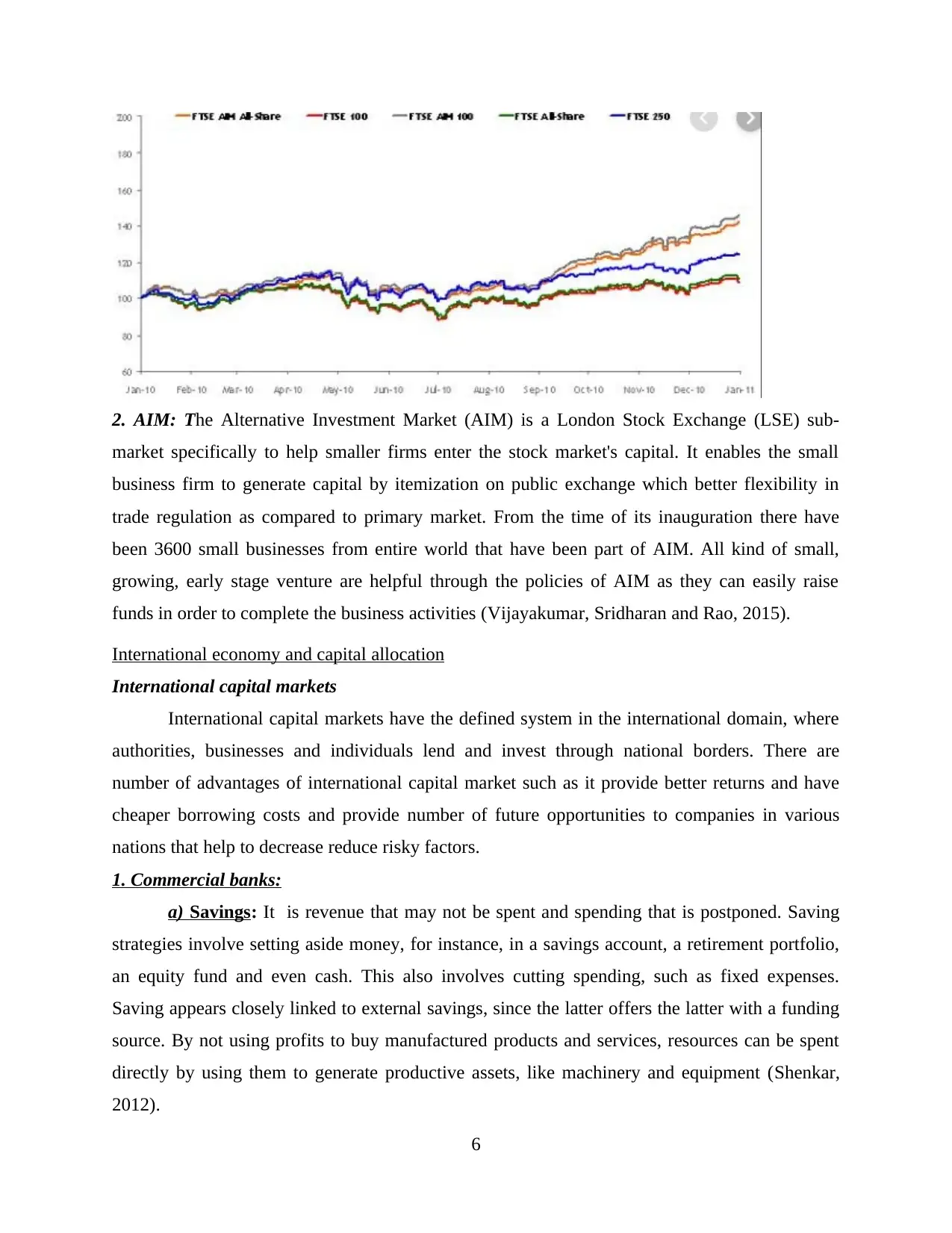
2. AIM: The Alternative Investment Market (AIM) is a London Stock Exchange (LSE) sub-
market specifically to help smaller firms enter the stock market's capital. It enables the small
business firm to generate capital by itemization on public exchange which better flexibility in
trade regulation as compared to primary market. From the time of its inauguration there have
been 3600 small businesses from entire world that have been part of AIM. All kind of small,
growing, early stage venture are helpful through the policies of AIM as they can easily raise
funds in order to complete the business activities (Vijayakumar, Sridharan and Rao, 2015).
International economy and capital allocation
International capital markets
International capital markets have the defined system in the international domain, where
authorities, businesses and individuals lend and invest through national borders. There are
number of advantages of international capital market such as it provide better returns and have
cheaper borrowing costs and provide number of future opportunities to companies in various
nations that help to decrease reduce risky factors.
1. Commercial banks:
a) Savings: It is revenue that may not be spent and spending that is postponed. Saving
strategies involve setting aside money, for instance, in a savings account, a retirement portfolio,
an equity fund and even cash. This also involves cutting spending, such as fixed expenses.
Saving appears closely linked to external savings, since the latter offers the latter with a funding
source. By not using profits to buy manufactured products and services, resources can be spent
directly by using them to generate productive assets, like machinery and equipment (Shenkar,
2012).
6
market specifically to help smaller firms enter the stock market's capital. It enables the small
business firm to generate capital by itemization on public exchange which better flexibility in
trade regulation as compared to primary market. From the time of its inauguration there have
been 3600 small businesses from entire world that have been part of AIM. All kind of small,
growing, early stage venture are helpful through the policies of AIM as they can easily raise
funds in order to complete the business activities (Vijayakumar, Sridharan and Rao, 2015).
International economy and capital allocation
International capital markets
International capital markets have the defined system in the international domain, where
authorities, businesses and individuals lend and invest through national borders. There are
number of advantages of international capital market such as it provide better returns and have
cheaper borrowing costs and provide number of future opportunities to companies in various
nations that help to decrease reduce risky factors.
1. Commercial banks:
a) Savings: It is revenue that may not be spent and spending that is postponed. Saving
strategies involve setting aside money, for instance, in a savings account, a retirement portfolio,
an equity fund and even cash. This also involves cutting spending, such as fixed expenses.
Saving appears closely linked to external savings, since the latter offers the latter with a funding
source. By not using profits to buy manufactured products and services, resources can be spent
directly by using them to generate productive assets, like machinery and equipment (Shenkar,
2012).
6
Secure Best Marks with AI Grader
Need help grading? Try our AI Grader for instant feedback on your assignments.
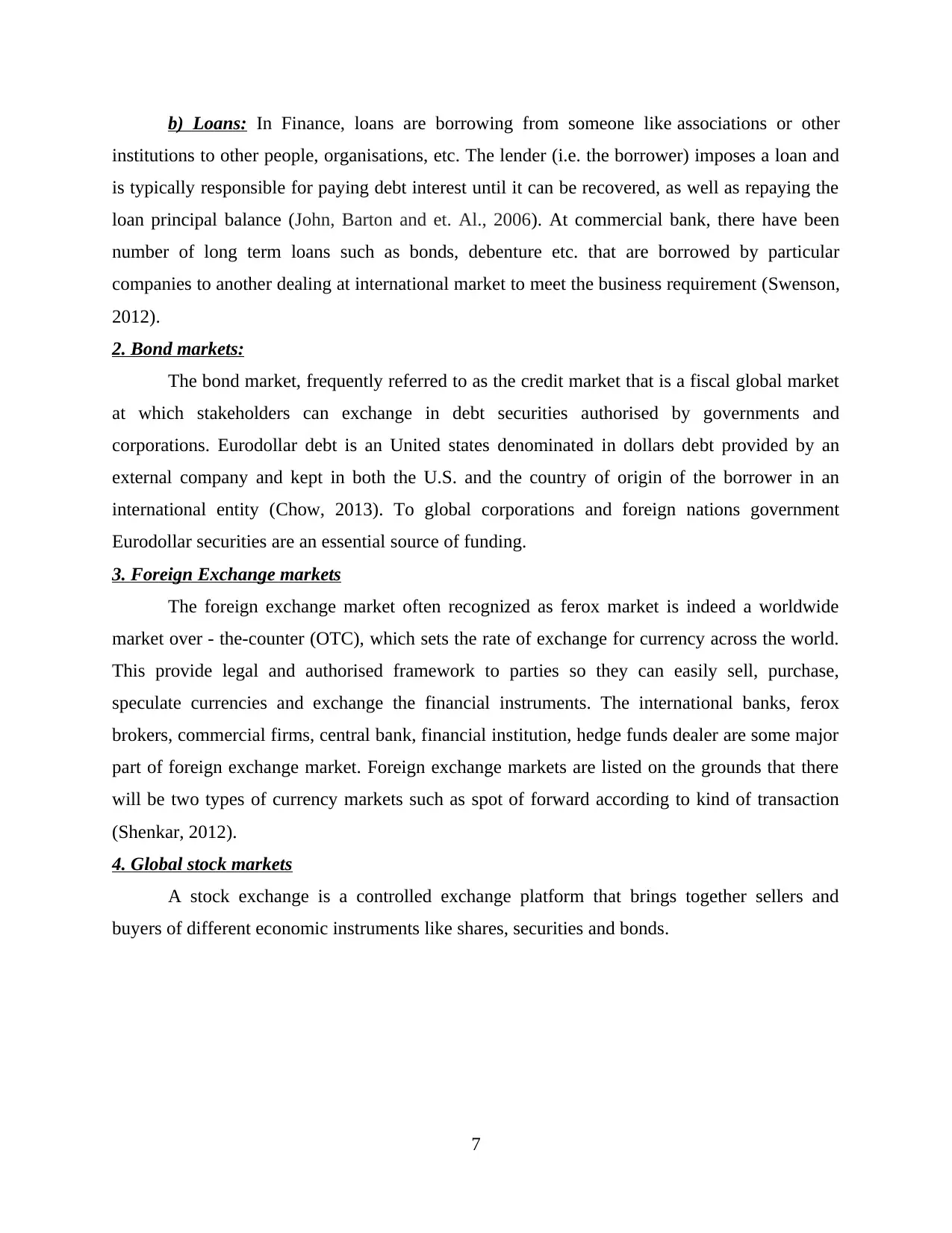
b) Loans: In Finance, loans are borrowing from someone like associations or other
institutions to other people, organisations, etc. The lender (i.e. the borrower) imposes a loan and
is typically responsible for paying debt interest until it can be recovered, as well as repaying the
loan principal balance (John, Barton and et. Al., 2006). At commercial bank, there have been
number of long term loans such as bonds, debenture etc. that are borrowed by particular
companies to another dealing at international market to meet the business requirement (Swenson,
2012).
2. Bond markets:
The bond market, frequently referred to as the credit market that is a fiscal global market
at which stakeholders can exchange in debt securities authorised by governments and
corporations. Eurodollar debt is an United states denominated in dollars debt provided by an
external company and kept in both the U.S. and the country of origin of the borrower in an
international entity (Chow, 2013). To global corporations and foreign nations government
Eurodollar securities are an essential source of funding.
3. Foreign Exchange markets
The foreign exchange market often recognized as ferox market is indeed a worldwide
market over - the-counter (OTC), which sets the rate of exchange for currency across the world.
This provide legal and authorised framework to parties so they can easily sell, purchase,
speculate currencies and exchange the financial instruments. The international banks, ferox
brokers, commercial firms, central bank, financial institution, hedge funds dealer are some major
part of foreign exchange market. Foreign exchange markets are listed on the grounds that there
will be two types of currency markets such as spot of forward according to kind of transaction
(Shenkar, 2012).
4. Global stock markets
A stock exchange is a controlled exchange platform that brings together sellers and
buyers of different economic instruments like shares, securities and bonds.
7
institutions to other people, organisations, etc. The lender (i.e. the borrower) imposes a loan and
is typically responsible for paying debt interest until it can be recovered, as well as repaying the
loan principal balance (John, Barton and et. Al., 2006). At commercial bank, there have been
number of long term loans such as bonds, debenture etc. that are borrowed by particular
companies to another dealing at international market to meet the business requirement (Swenson,
2012).
2. Bond markets:
The bond market, frequently referred to as the credit market that is a fiscal global market
at which stakeholders can exchange in debt securities authorised by governments and
corporations. Eurodollar debt is an United states denominated in dollars debt provided by an
external company and kept in both the U.S. and the country of origin of the borrower in an
international entity (Chow, 2013). To global corporations and foreign nations government
Eurodollar securities are an essential source of funding.
3. Foreign Exchange markets
The foreign exchange market often recognized as ferox market is indeed a worldwide
market over - the-counter (OTC), which sets the rate of exchange for currency across the world.
This provide legal and authorised framework to parties so they can easily sell, purchase,
speculate currencies and exchange the financial instruments. The international banks, ferox
brokers, commercial firms, central bank, financial institution, hedge funds dealer are some major
part of foreign exchange market. Foreign exchange markets are listed on the grounds that there
will be two types of currency markets such as spot of forward according to kind of transaction
(Shenkar, 2012).
4. Global stock markets
A stock exchange is a controlled exchange platform that brings together sellers and
buyers of different economic instruments like shares, securities and bonds.
7
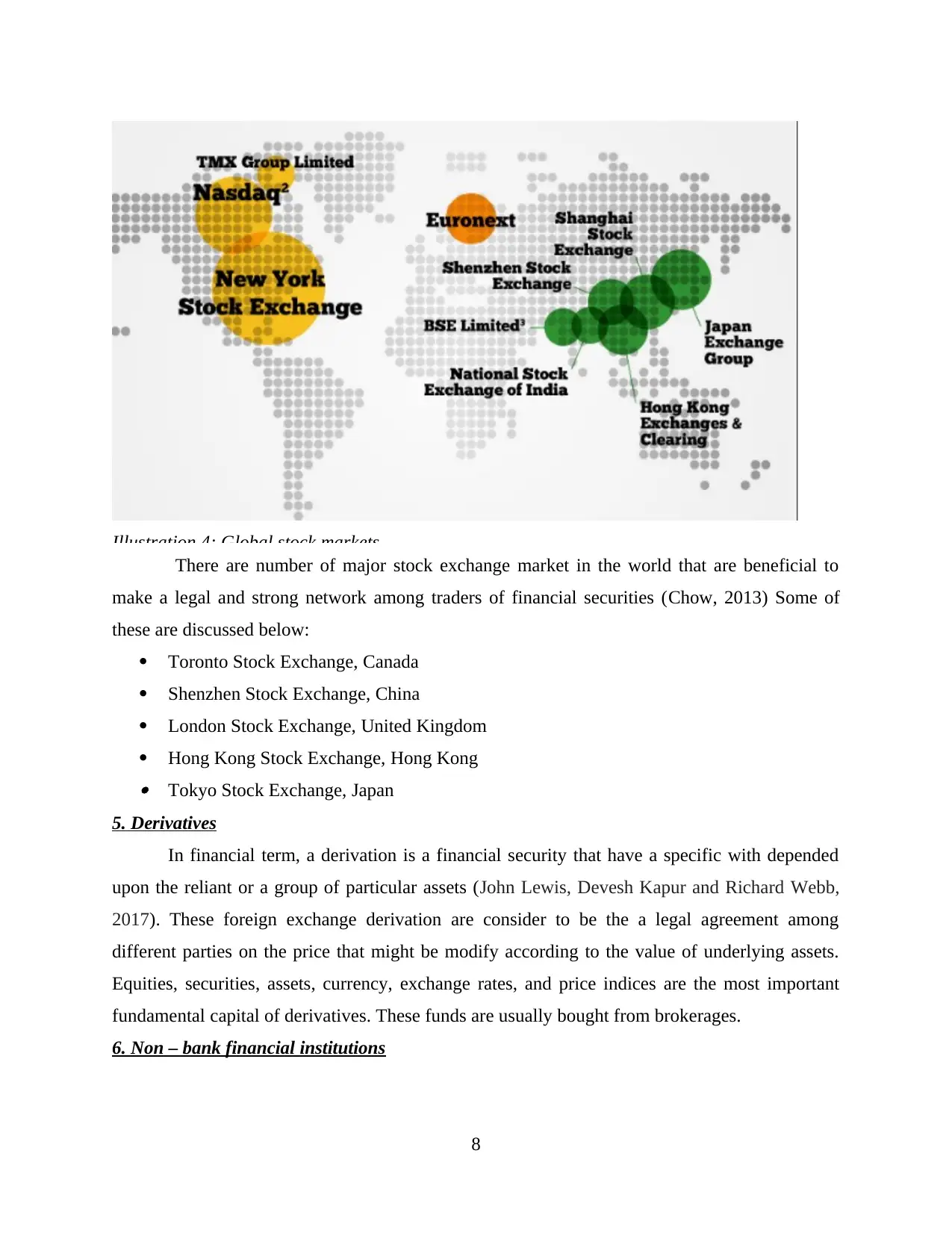
Illustration 4: Global stock markets
There are number of major stock exchange market in the world that are beneficial to
make a legal and strong network among traders of financial securities (Chow, 2013) Some of
these are discussed below:
Toronto Stock Exchange, Canada
Shenzhen Stock Exchange, China
London Stock Exchange, United Kingdom
Hong Kong Stock Exchange, Hong Kong Tokyo Stock Exchange, Japan
5. Derivatives
In financial term, a derivation is a financial security that have a specific with depended
upon the reliant or a group of particular assets (John Lewis, Devesh Kapur and Richard Webb,
2017). These foreign exchange derivation are consider to be the a legal agreement among
different parties on the price that might be modify according to the value of underlying assets.
Equities, securities, assets, currency, exchange rates, and price indices are the most important
fundamental capital of derivatives. These funds are usually bought from brokerages.
6. Non – bank financial institutions
8
There are number of major stock exchange market in the world that are beneficial to
make a legal and strong network among traders of financial securities (Chow, 2013) Some of
these are discussed below:
Toronto Stock Exchange, Canada
Shenzhen Stock Exchange, China
London Stock Exchange, United Kingdom
Hong Kong Stock Exchange, Hong Kong Tokyo Stock Exchange, Japan
5. Derivatives
In financial term, a derivation is a financial security that have a specific with depended
upon the reliant or a group of particular assets (John Lewis, Devesh Kapur and Richard Webb,
2017). These foreign exchange derivation are consider to be the a legal agreement among
different parties on the price that might be modify according to the value of underlying assets.
Equities, securities, assets, currency, exchange rates, and price indices are the most important
fundamental capital of derivatives. These funds are usually bought from brokerages.
6. Non – bank financial institutions
8
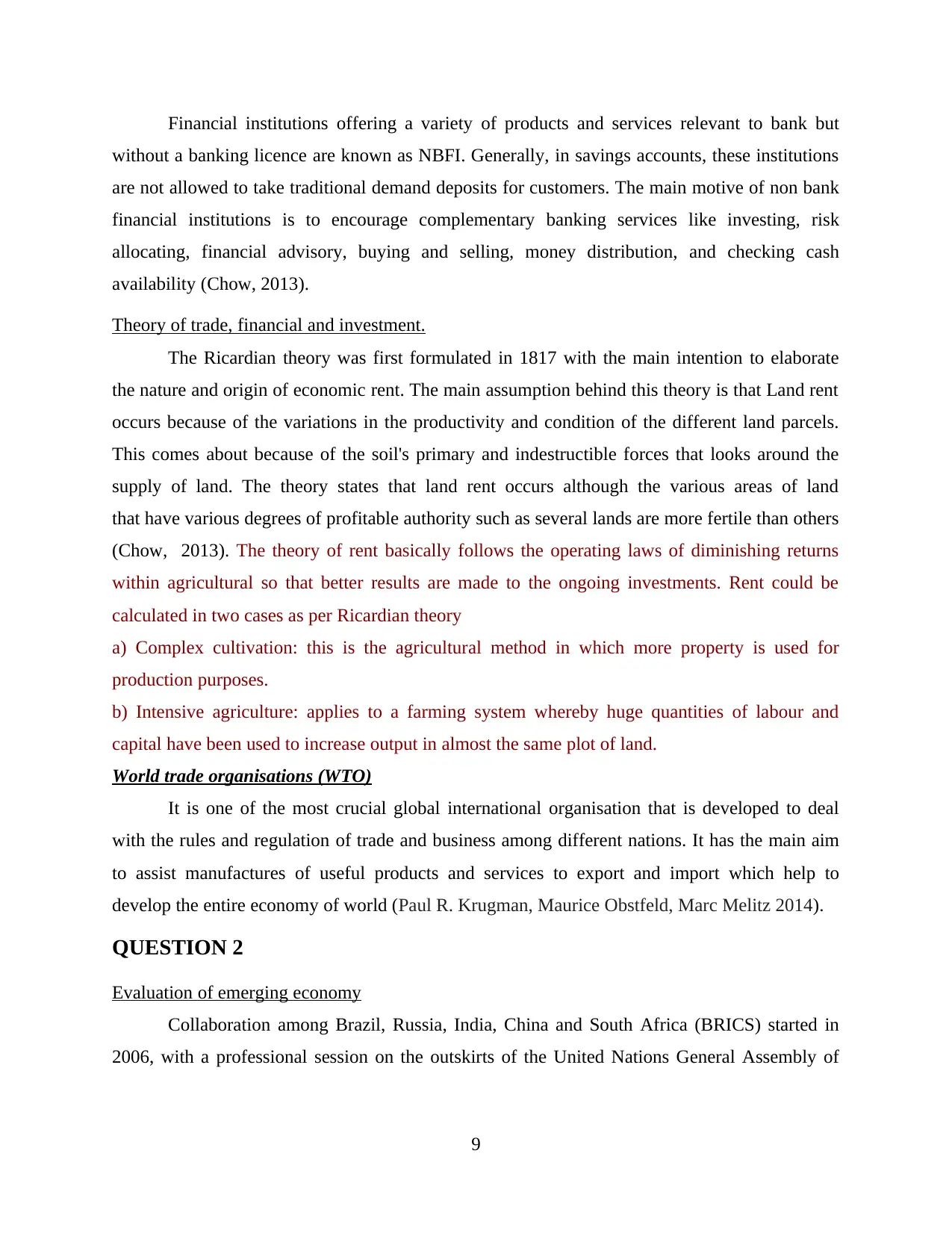
Financial institutions offering a variety of products and services relevant to bank but
without a banking licence are known as NBFI. Generally, in savings accounts, these institutions
are not allowed to take traditional demand deposits for customers. The main motive of non bank
financial institutions is to encourage complementary banking services like investing, risk
allocating, financial advisory, buying and selling, money distribution, and checking cash
availability (Chow, 2013).
Theory of trade, financial and investment.
The Ricardian theory was first formulated in 1817 with the main intention to elaborate
the nature and origin of economic rent. The main assumption behind this theory is that Land rent
occurs because of the variations in the productivity and condition of the different land parcels.
This comes about because of the soil's primary and indestructible forces that looks around the
supply of land. The theory states that land rent occurs although the various areas of land
that have various degrees of profitable authority such as several lands are more fertile than others
(Chow, 2013). The theory of rent basically follows the operating laws of diminishing returns
within agricultural so that better results are made to the ongoing investments. Rent could be
calculated in two cases as per Ricardian theory
a) Complex cultivation: this is the agricultural method in which more property is used for
production purposes.
b) Intensive agriculture: applies to a farming system whereby huge quantities of labour and
capital have been used to increase output in almost the same plot of land.
World trade organisations (WTO)
It is one of the most crucial global international organisation that is developed to deal
with the rules and regulation of trade and business among different nations. It has the main aim
to assist manufactures of useful products and services to export and import which help to
develop the entire economy of world (Paul R. Krugman, Maurice Obstfeld, Marc Melitz 2014).
QUESTION 2
Evaluation of emerging economy
Collaboration among Brazil, Russia, India, China and South Africa (BRICS) started in
2006, with a professional session on the outskirts of the United Nations General Assembly of
9
without a banking licence are known as NBFI. Generally, in savings accounts, these institutions
are not allowed to take traditional demand deposits for customers. The main motive of non bank
financial institutions is to encourage complementary banking services like investing, risk
allocating, financial advisory, buying and selling, money distribution, and checking cash
availability (Chow, 2013).
Theory of trade, financial and investment.
The Ricardian theory was first formulated in 1817 with the main intention to elaborate
the nature and origin of economic rent. The main assumption behind this theory is that Land rent
occurs because of the variations in the productivity and condition of the different land parcels.
This comes about because of the soil's primary and indestructible forces that looks around the
supply of land. The theory states that land rent occurs although the various areas of land
that have various degrees of profitable authority such as several lands are more fertile than others
(Chow, 2013). The theory of rent basically follows the operating laws of diminishing returns
within agricultural so that better results are made to the ongoing investments. Rent could be
calculated in two cases as per Ricardian theory
a) Complex cultivation: this is the agricultural method in which more property is used for
production purposes.
b) Intensive agriculture: applies to a farming system whereby huge quantities of labour and
capital have been used to increase output in almost the same plot of land.
World trade organisations (WTO)
It is one of the most crucial global international organisation that is developed to deal
with the rules and regulation of trade and business among different nations. It has the main aim
to assist manufactures of useful products and services to export and import which help to
develop the entire economy of world (Paul R. Krugman, Maurice Obstfeld, Marc Melitz 2014).
QUESTION 2
Evaluation of emerging economy
Collaboration among Brazil, Russia, India, China and South Africa (BRICS) started in
2006, with a professional session on the outskirts of the United Nations General Assembly of
9
Paraphrase This Document
Need a fresh take? Get an instant paraphrase of this document with our AI Paraphraser
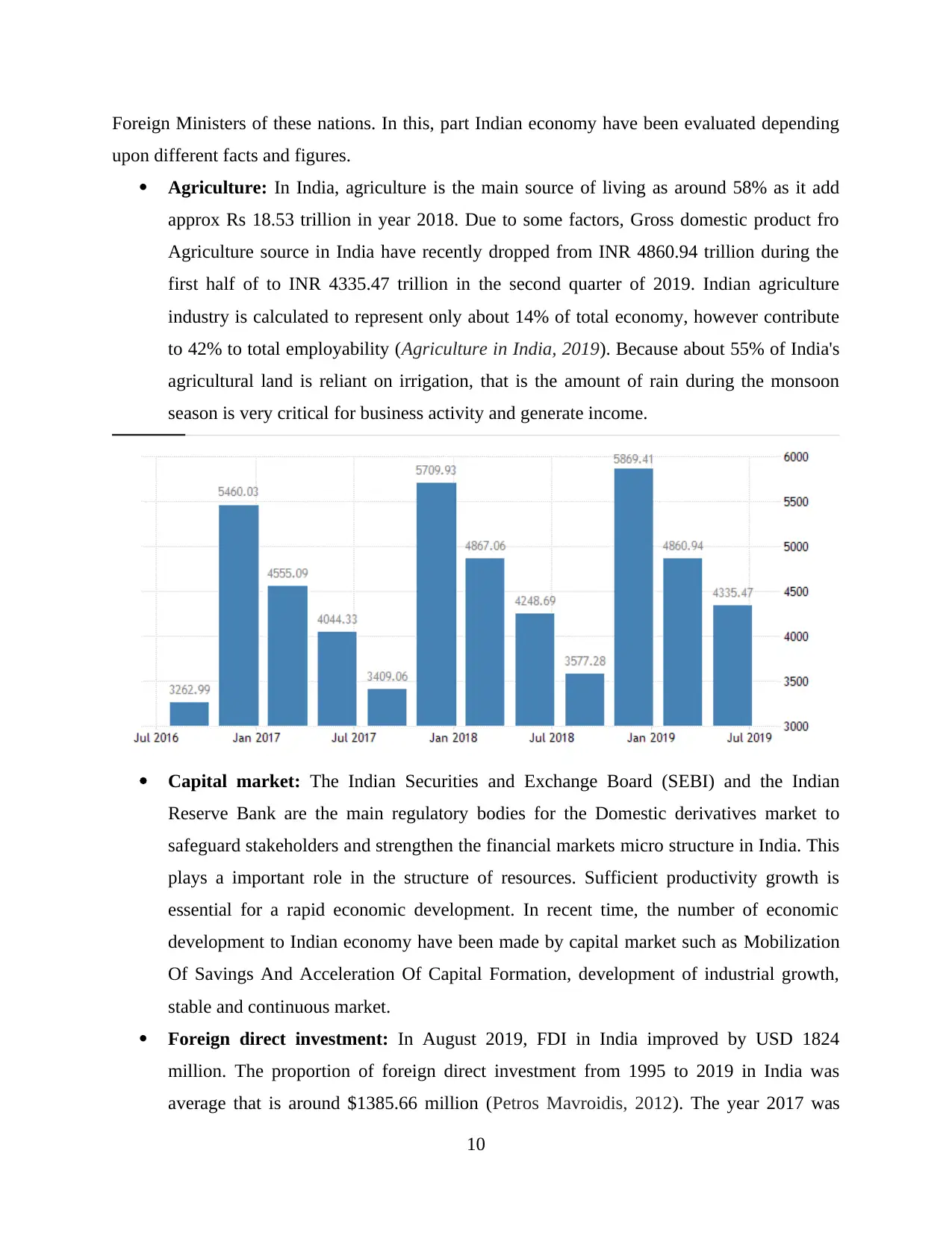
Foreign Ministers of these nations. In this, part Indian economy have been evaluated depending
upon different facts and figures.
Agriculture: In India, agriculture is the main source of living as around 58% as it add
approx Rs 18.53 trillion in year 2018. Due to some factors, Gross domestic product fro
Agriculture source in India have recently dropped from INR 4860.94 trillion during the
first half of to INR 4335.47 trillion in the second quarter of 2019. Indian agriculture
industry is calculated to represent only about 14% of total economy, however contribute
to 42% to total employability (Agriculture in India, 2019). Because about 55% of India's
agricultural land is reliant on irrigation, that is the amount of rain during the monsoon
season is very critical for business activity and generate income.
Capital market: The Indian Securities and Exchange Board (SEBI) and the Indian
Reserve Bank are the main regulatory bodies for the Domestic derivatives market to
safeguard stakeholders and strengthen the financial markets micro structure in India. This
plays a important role in the structure of resources. Sufficient productivity growth is
essential for a rapid economic development. In recent time, the number of economic
development to Indian economy have been made by capital market such as Mobilization
Of Savings And Acceleration Of Capital Formation, development of industrial growth,
stable and continuous market.
Foreign direct investment: In August 2019, FDI in India improved by USD 1824
million. The proportion of foreign direct investment from 1995 to 2019 in India was
average that is around $1385.66 million (Petros Mavroidis, 2012). The year 2017 was
10
upon different facts and figures.
Agriculture: In India, agriculture is the main source of living as around 58% as it add
approx Rs 18.53 trillion in year 2018. Due to some factors, Gross domestic product fro
Agriculture source in India have recently dropped from INR 4860.94 trillion during the
first half of to INR 4335.47 trillion in the second quarter of 2019. Indian agriculture
industry is calculated to represent only about 14% of total economy, however contribute
to 42% to total employability (Agriculture in India, 2019). Because about 55% of India's
agricultural land is reliant on irrigation, that is the amount of rain during the monsoon
season is very critical for business activity and generate income.
Capital market: The Indian Securities and Exchange Board (SEBI) and the Indian
Reserve Bank are the main regulatory bodies for the Domestic derivatives market to
safeguard stakeholders and strengthen the financial markets micro structure in India. This
plays a important role in the structure of resources. Sufficient productivity growth is
essential for a rapid economic development. In recent time, the number of economic
development to Indian economy have been made by capital market such as Mobilization
Of Savings And Acceleration Of Capital Formation, development of industrial growth,
stable and continuous market.
Foreign direct investment: In August 2019, FDI in India improved by USD 1824
million. The proportion of foreign direct investment from 1995 to 2019 in India was
average that is around $1385.66 million (Petros Mavroidis, 2012). The year 2017 was
10
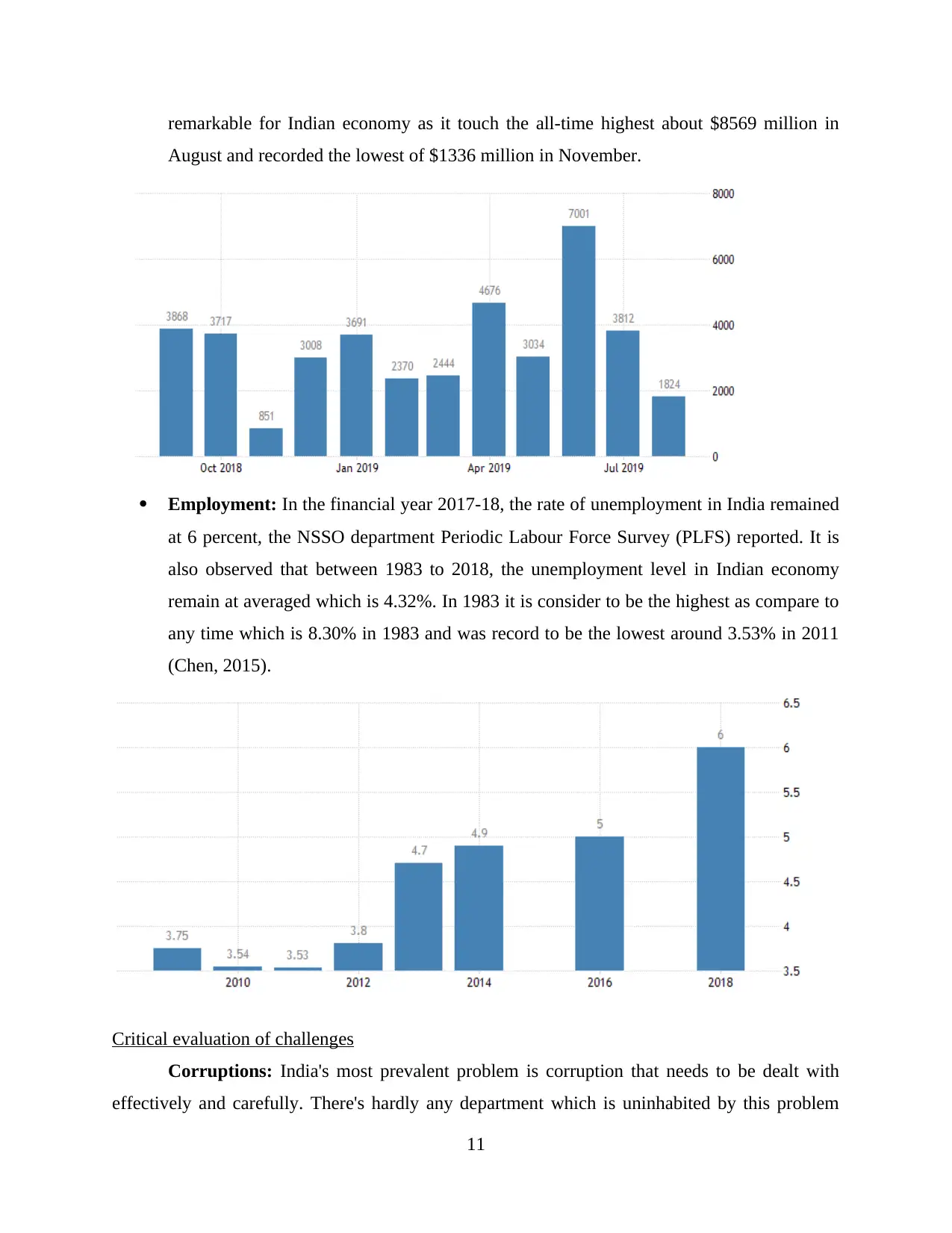
remarkable for Indian economy as it touch the all-time highest about $8569 million in
August and recorded the lowest of $1336 million in November.
Employment: In the financial year 2017-18, the rate of unemployment in India remained
at 6 percent, the NSSO department Periodic Labour Force Survey (PLFS) reported. It is
also observed that between 1983 to 2018, the unemployment level in Indian economy
remain at averaged which is 4.32%. In 1983 it is consider to be the highest as compare to
any time which is 8.30% in 1983 and was record to be the lowest around 3.53% in 2011
(Chen, 2015).
Critical evaluation of challenges
Corruptions: India's most prevalent problem is corruption that needs to be dealt with
effectively and carefully. There's hardly any department which is uninhabited by this problem
11
August and recorded the lowest of $1336 million in November.
Employment: In the financial year 2017-18, the rate of unemployment in India remained
at 6 percent, the NSSO department Periodic Labour Force Survey (PLFS) reported. It is
also observed that between 1983 to 2018, the unemployment level in Indian economy
remain at averaged which is 4.32%. In 1983 it is consider to be the highest as compare to
any time which is 8.30% in 1983 and was record to be the lowest around 3.53% in 2011
(Chen, 2015).
Critical evaluation of challenges
Corruptions: India's most prevalent problem is corruption that needs to be dealt with
effectively and carefully. There's hardly any department which is uninhabited by this problem
11
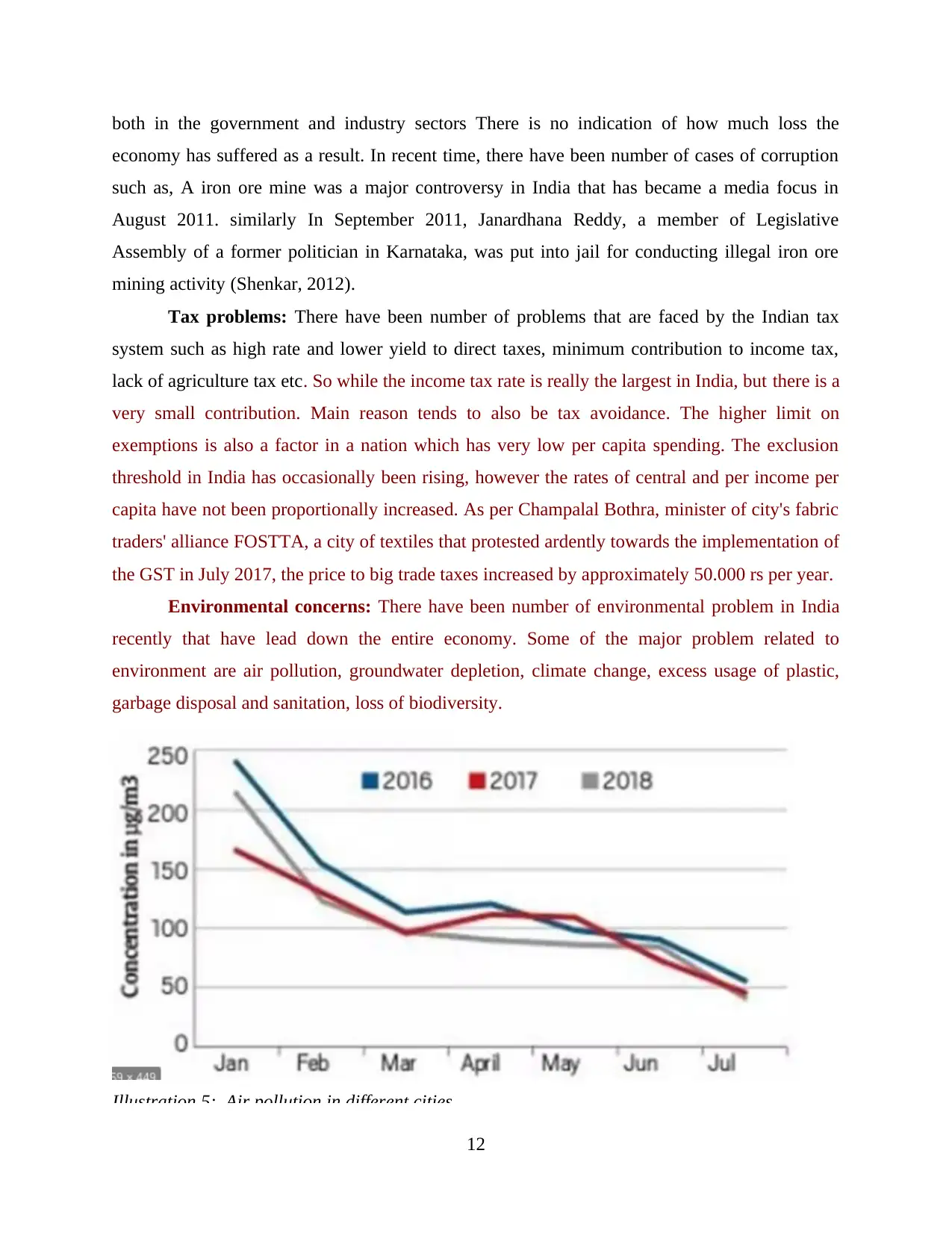
both in the government and industry sectors There is no indication of how much loss the
economy has suffered as a result. In recent time, there have been number of cases of corruption
such as, A iron ore mine was a major controversy in India that has became a media focus in
August 2011. similarly In September 2011, Janardhana Reddy, a member of Legislative
Assembly of a former politician in Karnataka, was put into jail for conducting illegal iron ore
mining activity (Shenkar, 2012).
Tax problems: There have been number of problems that are faced by the Indian tax
system such as high rate and lower yield to direct taxes, minimum contribution to income tax,
lack of agriculture tax etc. So while the income tax rate is really the largest in India, but there is a
very small contribution. Main reason tends to also be tax avoidance. The higher limit on
exemptions is also a factor in a nation which has very low per capita spending. The exclusion
threshold in India has occasionally been rising, however the rates of central and per income per
capita have not been proportionally increased. As per Champalal Bothra, minister of city's fabric
traders' alliance FOSTTA, a city of textiles that protested ardently towards the implementation of
the GST in July 2017, the price to big trade taxes increased by approximately 50.000 rs per year.
Environmental concerns: There have been number of environmental problem in India
recently that have lead down the entire economy. Some of the major problem related to
environment are air pollution, groundwater depletion, climate change, excess usage of plastic,
garbage disposal and sanitation, loss of biodiversity.
Illustration 5: Air pollution in different cities
12
economy has suffered as a result. In recent time, there have been number of cases of corruption
such as, A iron ore mine was a major controversy in India that has became a media focus in
August 2011. similarly In September 2011, Janardhana Reddy, a member of Legislative
Assembly of a former politician in Karnataka, was put into jail for conducting illegal iron ore
mining activity (Shenkar, 2012).
Tax problems: There have been number of problems that are faced by the Indian tax
system such as high rate and lower yield to direct taxes, minimum contribution to income tax,
lack of agriculture tax etc. So while the income tax rate is really the largest in India, but there is a
very small contribution. Main reason tends to also be tax avoidance. The higher limit on
exemptions is also a factor in a nation which has very low per capita spending. The exclusion
threshold in India has occasionally been rising, however the rates of central and per income per
capita have not been proportionally increased. As per Champalal Bothra, minister of city's fabric
traders' alliance FOSTTA, a city of textiles that protested ardently towards the implementation of
the GST in July 2017, the price to big trade taxes increased by approximately 50.000 rs per year.
Environmental concerns: There have been number of environmental problem in India
recently that have lead down the entire economy. Some of the major problem related to
environment are air pollution, groundwater depletion, climate change, excess usage of plastic,
garbage disposal and sanitation, loss of biodiversity.
Illustration 5: Air pollution in different cities
12
Secure Best Marks with AI Grader
Need help grading? Try our AI Grader for instant feedback on your assignments.
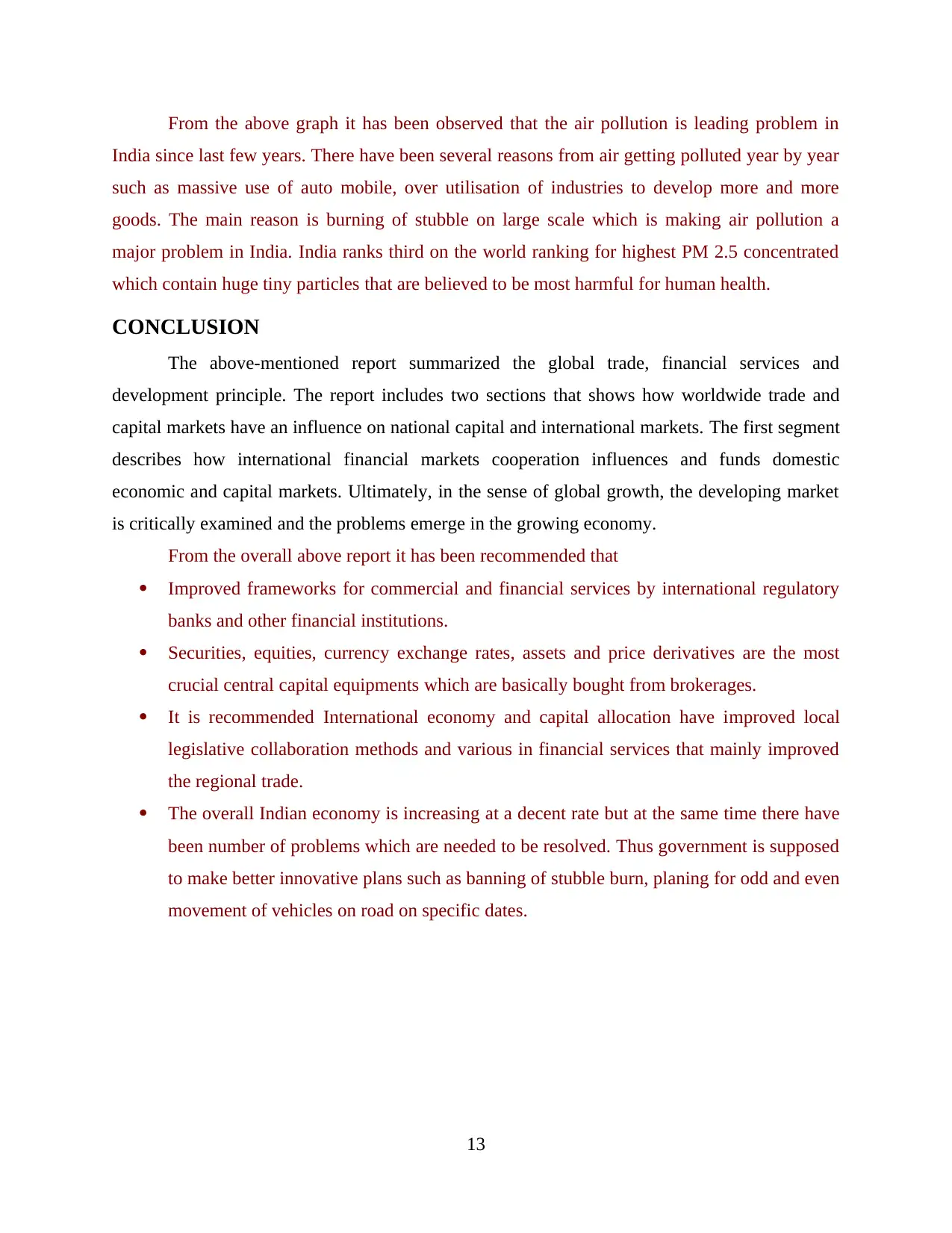
From the above graph it has been observed that the air pollution is leading problem in
India since last few years. There have been several reasons from air getting polluted year by year
such as massive use of auto mobile, over utilisation of industries to develop more and more
goods. The main reason is burning of stubble on large scale which is making air pollution a
major problem in India. India ranks third on the world ranking for highest PM 2.5 concentrated
which contain huge tiny particles that are believed to be most harmful for human health.
CONCLUSION
The above-mentioned report summarized the global trade, financial services and
development principle. The report includes two sections that shows how worldwide trade and
capital markets have an influence on national capital and international markets. The first segment
describes how international financial markets cooperation influences and funds domestic
economic and capital markets. Ultimately, in the sense of global growth, the developing market
is critically examined and the problems emerge in the growing economy.
From the overall above report it has been recommended that
Improved frameworks for commercial and financial services by international regulatory
banks and other financial institutions.
Securities, equities, currency exchange rates, assets and price derivatives are the most
crucial central capital equipments which are basically bought from brokerages.
It is recommended International economy and capital allocation have improved local
legislative collaboration methods and various in financial services that mainly improved
the regional trade.
The overall Indian economy is increasing at a decent rate but at the same time there have
been number of problems which are needed to be resolved. Thus government is supposed
to make better innovative plans such as banning of stubble burn, planing for odd and even
movement of vehicles on road on specific dates.
13
India since last few years. There have been several reasons from air getting polluted year by year
such as massive use of auto mobile, over utilisation of industries to develop more and more
goods. The main reason is burning of stubble on large scale which is making air pollution a
major problem in India. India ranks third on the world ranking for highest PM 2.5 concentrated
which contain huge tiny particles that are believed to be most harmful for human health.
CONCLUSION
The above-mentioned report summarized the global trade, financial services and
development principle. The report includes two sections that shows how worldwide trade and
capital markets have an influence on national capital and international markets. The first segment
describes how international financial markets cooperation influences and funds domestic
economic and capital markets. Ultimately, in the sense of global growth, the developing market
is critically examined and the problems emerge in the growing economy.
From the overall above report it has been recommended that
Improved frameworks for commercial and financial services by international regulatory
banks and other financial institutions.
Securities, equities, currency exchange rates, assets and price derivatives are the most
crucial central capital equipments which are basically bought from brokerages.
It is recommended International economy and capital allocation have improved local
legislative collaboration methods and various in financial services that mainly improved
the regional trade.
The overall Indian economy is increasing at a decent rate but at the same time there have
been number of problems which are needed to be resolved. Thus government is supposed
to make better innovative plans such as banning of stubble burn, planing for odd and even
movement of vehicles on road on specific dates.
13
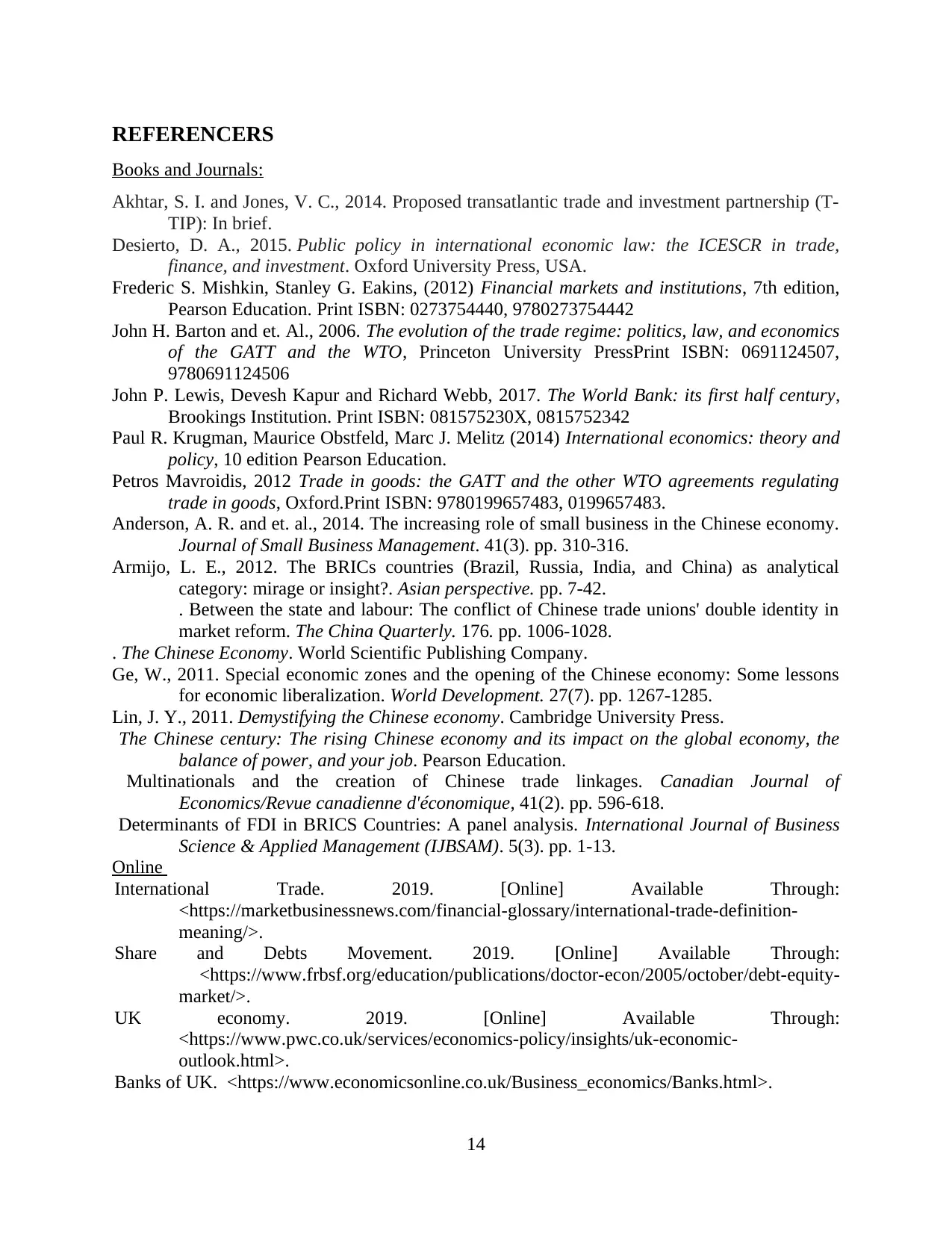
REFERENCERS
Books and Journals:
Akhtar, S. I. and Jones, V. C., 2014. Proposed transatlantic trade and investment partnership (T-
TIP): In brief.
Desierto, D. A., 2015. Public policy in international economic law: the ICESCR in trade,
finance, and investment. Oxford University Press, USA.
Frederic S. Mishkin, Stanley G. Eakins, (2012) Financial markets and institutions, 7th edition,
Pearson Education. Print ISBN: 0273754440, 9780273754442
John H. Barton and et. Al., 2006. The evolution of the trade regime: politics, law, and economics
of the GATT and the WTO, Princeton University PressPrint ISBN: 0691124507,
9780691124506
John P. Lewis, Devesh Kapur and Richard Webb, 2017. The World Bank: its first half century,
Brookings Institution. Print ISBN: 081575230X, 0815752342
Paul R. Krugman, Maurice Obstfeld, Marc J. Melitz (2014) International economics: theory and
policy, 10 edition Pearson Education.
Petros Mavroidis, 2012 Trade in goods: the GATT and the other WTO agreements regulating
trade in goods, Oxford.Print ISBN: 9780199657483, 0199657483.
Anderson, A. R. and et. al., 2014. The increasing role of small business in the Chinese economy.
Journal of Small Business Management. 41(3). pp. 310-316.
Armijo, L. E., 2012. The BRICs countries (Brazil, Russia, India, and China) as analytical
category: mirage or insight?. Asian perspective. pp. 7-42.
. Between the state and labour: The conflict of Chinese trade unions' double identity in
market reform. The China Quarterly. 176. pp. 1006-1028.
. The Chinese Economy. World Scientific Publishing Company.
Ge, W., 2011. Special economic zones and the opening of the Chinese economy: Some lessons
for economic liberalization. World Development. 27(7). pp. 1267-1285.
Lin, J. Y., 2011. Demystifying the Chinese economy. Cambridge University Press.
The Chinese century: The rising Chinese economy and its impact on the global economy, the
balance of power, and your job. Pearson Education.
Multinationals and the creation of Chinese trade linkages. Canadian Journal of
Economics/Revue canadienne d'économique, 41(2). pp. 596-618.
Determinants of FDI in BRICS Countries: A panel analysis. International Journal of Business
Science & Applied Management (IJBSAM). 5(3). pp. 1-13.
Online
International Trade. 2019. [Online] Available Through:
<https://marketbusinessnews.com/financial-glossary/international-trade-definition-
meaning/>.
Share and Debts Movement. 2019. [Online] Available Through:
<https://www.frbsf.org/education/publications/doctor-econ/2005/october/debt-equity-
market/>.
UK economy. 2019. [Online] Available Through:
<https://www.pwc.co.uk/services/economics-policy/insights/uk-economic-
outlook.html>.
Banks of UK. <https://www.economicsonline.co.uk/Business_economics/Banks.html>.
14
Books and Journals:
Akhtar, S. I. and Jones, V. C., 2014. Proposed transatlantic trade and investment partnership (T-
TIP): In brief.
Desierto, D. A., 2015. Public policy in international economic law: the ICESCR in trade,
finance, and investment. Oxford University Press, USA.
Frederic S. Mishkin, Stanley G. Eakins, (2012) Financial markets and institutions, 7th edition,
Pearson Education. Print ISBN: 0273754440, 9780273754442
John H. Barton and et. Al., 2006. The evolution of the trade regime: politics, law, and economics
of the GATT and the WTO, Princeton University PressPrint ISBN: 0691124507,
9780691124506
John P. Lewis, Devesh Kapur and Richard Webb, 2017. The World Bank: its first half century,
Brookings Institution. Print ISBN: 081575230X, 0815752342
Paul R. Krugman, Maurice Obstfeld, Marc J. Melitz (2014) International economics: theory and
policy, 10 edition Pearson Education.
Petros Mavroidis, 2012 Trade in goods: the GATT and the other WTO agreements regulating
trade in goods, Oxford.Print ISBN: 9780199657483, 0199657483.
Anderson, A. R. and et. al., 2014. The increasing role of small business in the Chinese economy.
Journal of Small Business Management. 41(3). pp. 310-316.
Armijo, L. E., 2012. The BRICs countries (Brazil, Russia, India, and China) as analytical
category: mirage or insight?. Asian perspective. pp. 7-42.
. Between the state and labour: The conflict of Chinese trade unions' double identity in
market reform. The China Quarterly. 176. pp. 1006-1028.
. The Chinese Economy. World Scientific Publishing Company.
Ge, W., 2011. Special economic zones and the opening of the Chinese economy: Some lessons
for economic liberalization. World Development. 27(7). pp. 1267-1285.
Lin, J. Y., 2011. Demystifying the Chinese economy. Cambridge University Press.
The Chinese century: The rising Chinese economy and its impact on the global economy, the
balance of power, and your job. Pearson Education.
Multinationals and the creation of Chinese trade linkages. Canadian Journal of
Economics/Revue canadienne d'économique, 41(2). pp. 596-618.
Determinants of FDI in BRICS Countries: A panel analysis. International Journal of Business
Science & Applied Management (IJBSAM). 5(3). pp. 1-13.
Online
International Trade. 2019. [Online] Available Through:
<https://marketbusinessnews.com/financial-glossary/international-trade-definition-
meaning/>.
Share and Debts Movement. 2019. [Online] Available Through:
<https://www.frbsf.org/education/publications/doctor-econ/2005/october/debt-equity-
market/>.
UK economy. 2019. [Online] Available Through:
<https://www.pwc.co.uk/services/economics-policy/insights/uk-economic-
outlook.html>.
Banks of UK. <https://www.economicsonline.co.uk/Business_economics/Banks.html>.
14
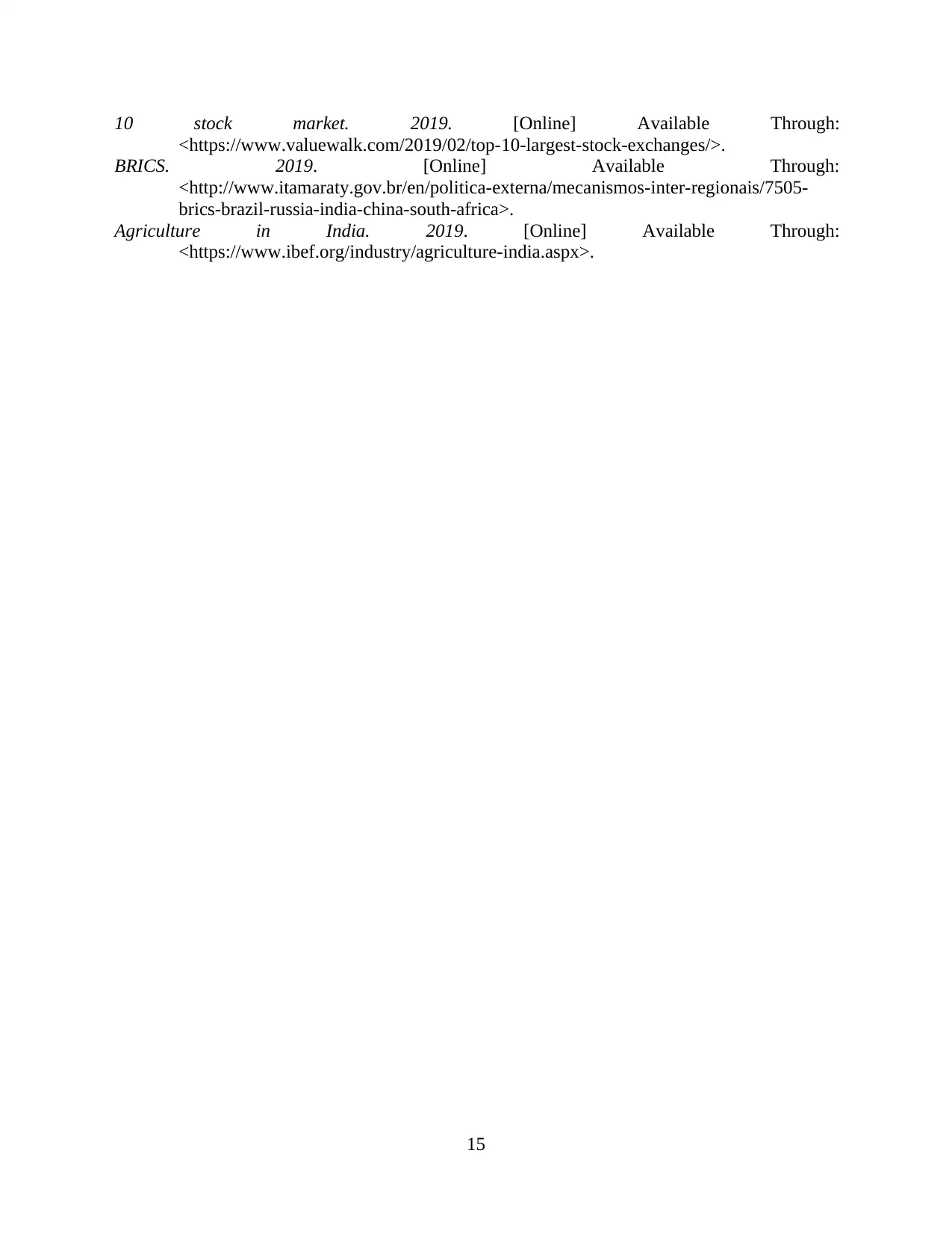
10 stock market. 2019. [Online] Available Through:
<https://www.valuewalk.com/2019/02/top-10-largest-stock-exchanges/>.
BRICS. 2019. [Online] Available Through:
<http://www.itamaraty.gov.br/en/politica-externa/mecanismos-inter-regionais/7505-
brics-brazil-russia-india-china-south-africa>.
Agriculture in India. 2019. [Online] Available Through:
<https://www.ibef.org/industry/agriculture-india.aspx>.
15
<https://www.valuewalk.com/2019/02/top-10-largest-stock-exchanges/>.
BRICS. 2019. [Online] Available Through:
<http://www.itamaraty.gov.br/en/politica-externa/mecanismos-inter-regionais/7505-
brics-brazil-russia-india-china-south-africa>.
Agriculture in India. 2019. [Online] Available Through:
<https://www.ibef.org/industry/agriculture-india.aspx>.
15
1 out of 19
Related Documents
Your All-in-One AI-Powered Toolkit for Academic Success.
+13062052269
info@desklib.com
Available 24*7 on WhatsApp / Email
![[object Object]](/_next/static/media/star-bottom.7253800d.svg)
Unlock your academic potential
© 2024 | Zucol Services PVT LTD | All rights reserved.





